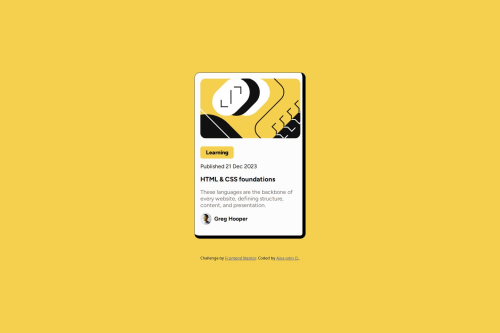Responsive Blog Preview Card #HTML #CSS

Solution retrospective
My first time of making a responsive page project without the use of @media-query , at first it doesn't look right but later on it went smoothly. Looking forward to make more good looking project with Media Query.
What specific areas of your project would you like help with?Anything that can help me make progress. Any feedback or question are welcome ! Thanks
Please log in to post a comment
Log in with GitHubCommunity feedback
- @BANKOLEDO
Nice layout but try to make your container larger and clearer
Marked as helpful - @DylandeBruijn
@Jorge-234
Hiya! 👋
Congratulations on your solution, it looks very close to the design! I can tell you put a lot of effort into it.
Things you could improve ✍️
-
I suggest adding a bit of
paddingto yourbodyelement so the card has some space around it on smaller viewports. -
You could add a
min-height: 100vhto yourbodyelement so it takes up the full height of the viewport while still being able to grow when the content inside it grows. -
Try experimenting with CSS variables, they help you make your CSS values more reusable across your code.
-
I suggest using clear descriptive CSS classes like
.card,.card-titleand.card-description. -
Try using semantic HTML elements like
main,sectionandarticle. -
Your image isn't loading for me.
I hope you find my feedback helpful! 🌟
Let me know if you have more questions and I'll do my best to answer them. 🙋♂️
Happy coding! 😎
-
Join our Discord community
Join thousands of Frontend Mentor community members taking the challenges, sharing resources, helping each other, and chatting about all things front-end!
Join our Discord